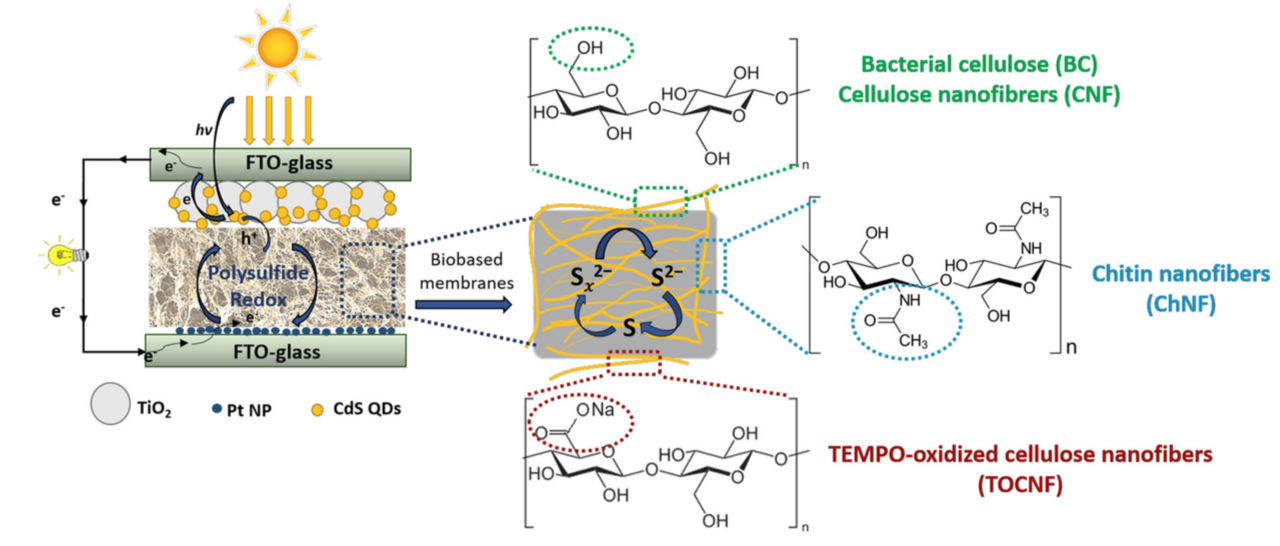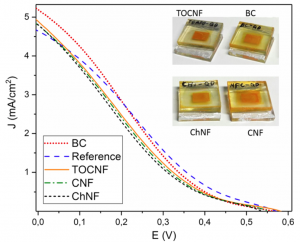Quantum dot-sensitized solar cells (QDSCs) are the third generation of solar cells, using quantum dots as the absorbing photovoltaic material, which allow for larger theoretical efficiencies than conventional silica based cells.
In addition to the major problems of this cell type — insufficient light absorption and electron hole recombination on the QD-electrolyte interface — which have been addressed in recent years yielding efficiencies up to 11 %, one great obstacle standing in the way of their large scale implementation is electrolyte loss due to evaporation. To avoid this undesired leakage of electrolyte entailing inferior cell performance, solid electrolyte carrier membranes have been introduced. Generally, synthetic polymer membranes have been deployed for this purpose. However, in light of environmental aspects, requiring a shift towards bio-compatible and renewable components, bio-based membranes are a logical replacement for their synthetic counterparts.
With the aim of devising biocompatible QDSC carrier membranes, scientists from the Aalto University in Finland have tested bio-based aerogel materials in QDSC cells, consisting of a CdS-sensitized photo-anode, a Pt counter electrode and a polysulfide redox electrolyte (see figure below).
To investigate the effect of different biopolymers, aerogels consisting of bacterial cellulose (BC), cellulose nanofibers (CNF), chitin nanofibers (ChNF) and TEMPO-oxidized CNF (TOCNF) were synthesized via gelation, solvent exchange and freeze-drying. Apart from their different fibrillar structures, the polymers exhibited a variety of different functional groups and surface charges, facilitating an investigation of the impact of these properties on cell performance.
Subsequent to gel drying, the aerogel samples were soaked with the polysulfide electrolyte, yielding free standing, flexible and stable structures in all four cases, allowing for easy sample handling and cell assembly.
The resulting membrane equipped QDSCs were then tested under irradiation of one sun (=1000 W/m2) to compare their performance to that of a reference cell filled with the untapped liquid electrolyte. All samples exhibited a similar photocurrent-voltage behavior, which can be seen in the figure on the right. Furthermore, the obtained values for the internal charge transfer resistance were comparable for all five cell type, suggesting that the membranes did not interfere with the internal charge transfer. Lastly, it was determined that neither membrane type had any detrimental effects on the polysulfide redox reaction, despite the difference surface charges of the deployed polymers.
In light of these findings, the authors concluded that cellulose and chitin based aerogels are suitable materials for organic electrolyte carrier membranes in QDSCs, since the performance of all aerogel-equipped samples was on par with that of the membrane-free reference cell. Out of the four different precursor materials, the researchers see the greatest promise in BC aerogels, due to its cost-efficient production technique via microbial fermentation and the resulting high purity of the biopolymer, guaranteeing a cheap and straight-forward production of BC aerogel membranes.
Certainly, the presented study can only be considered as an initial foray into the field of bio-based aerogel electrolyte carrier membranes. Future work will have to investigate the performance of such materials in more elaborate QDSC architectures to assess their potential for large scale implementation. Still, this pioneering work encourages endeavors aiming at the application of aerogel materials in photovoltaics. In case further work on this topic will underpin these findings, aerogels surely have the potential to become integral building blocks of next generation solar cells.
More details: Borghei et al. “Biobased aerogels with different surface charge as electrolyte carrier membranes in quantum dot-sensitized solar cell” Cellulose, 2018. https://doi.org/10.1007/s10570-018-1807-2


